Callicarpa americana
How can you not immediately fall in love with a plant called “American beautyberry”? It just makes the heart swell. Here, take a Kleenex.
The emotive lexicon is well deserved.
This large, deciduous shrub, native to the southeastern United States, is truly beautiful.
With long, arching branches bearing large, light green leaves, and clusters of little flowers that morph into green and then brilliant purple berries containing three to four seeds each.
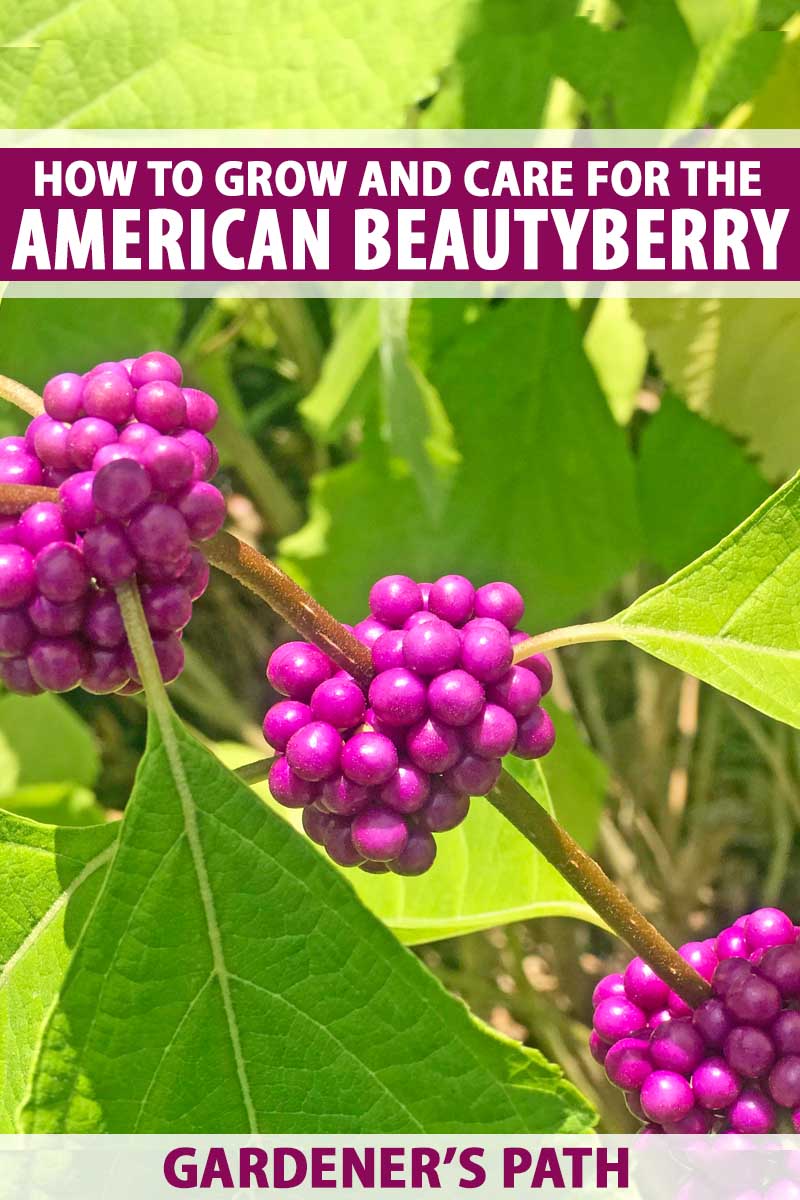
We link to vendors to help you find relevant products. If you buy from one of our links, we may earn a commission.
The juicy berries are a source of food for more than 40 species of songbird, including the American robin, mockingbirds, woodpeckers and finches.
Armadillos, foxes, opossum, squirrels, and raccoons like the berries, too. When desperately hungry, deer will eat the leaves of the plant and they’ll eat the berries after they’ve dropped.
Humans can eat the berries, too; they’re said to have a medicinal flavor when eaten raw.
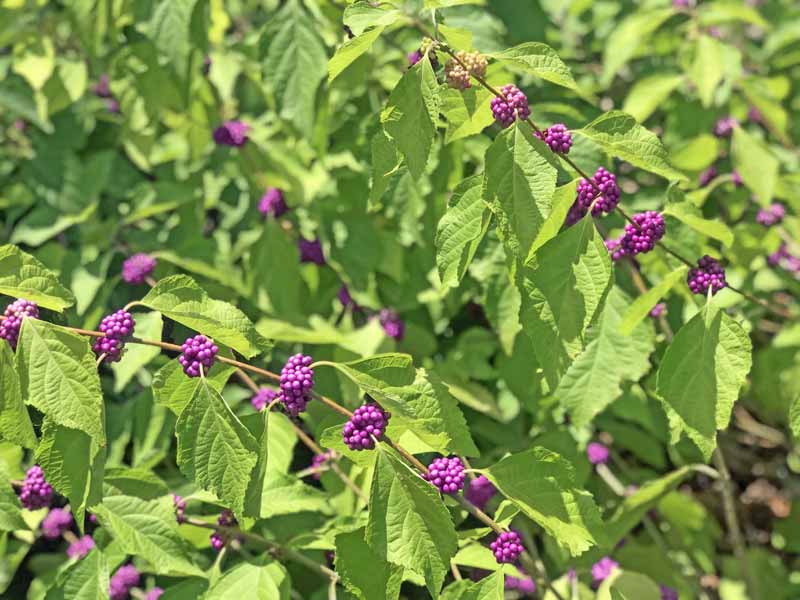
They can also be made into jam. Some people have reported upset stomach after eating the berries, however, so it might be best to try just a few before eating a big ol’ slice of beautyberry pie.
If animals and people don’t eat them all, the berries will persist well into winter, even after the leaves have all fallen.
What You’ll Learn
American beautyberry is appreciated for its fall interest – bright yellow leaves and, of course, the lovely bb-sized purple berries.
Cultivation and History
Native American tribes used the roots, leaves, and branches to treat malarial fevers and rheumatism. The roots were used to treat dizziness, stomachaches and dysentery.
Roots and berries were boiled and made into a drink to treat colic.
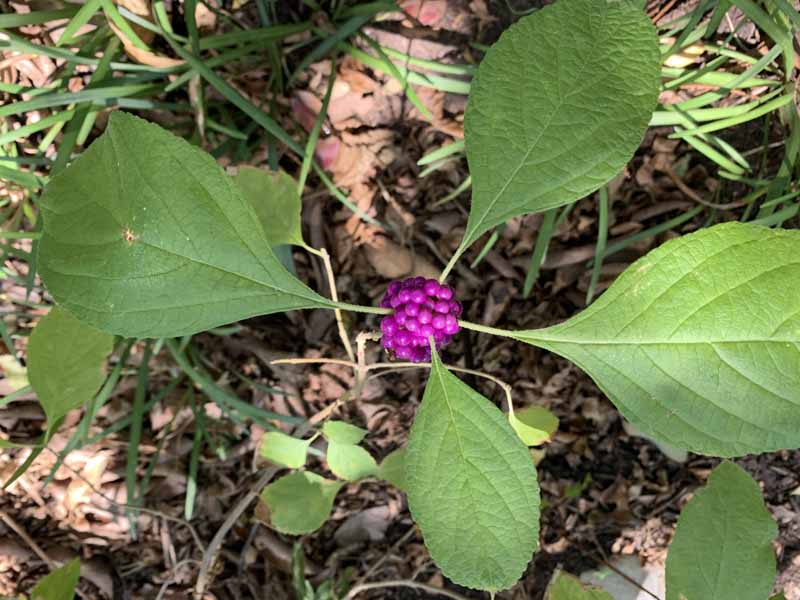
In the early 1900s, farmers crushed the leaves and placed them under the harnesses of horses to repel mosquitoes.
They also rubbed the crushed leaves on their skin to repel mosquitoes and other biting bugs.
Propagation
You can propagate this shrub from seed or by taking softwood stem cuttings.
From Seed
If growing from seed, soak the seeds in clean, cool water for 24 hours.
If you want to start seeds indoors, sow 1/16-inch deep in small pots or seedling trays filled with seed-starter potting mix. Place trays or pots in a warm, sunny area.
Keep the soil lightly moist via a spray-bottle mister until the seedlings are transplant size, about three months after sowing.
This plant also liberally reseeds itself.
For direct sowing, you can sow seeds in fall, before first frost or in spring, after all danger of frost has passed.
From Cuttings
You can propagate beautyberry from softwood cuttings in spring. Softwood is a stem that is not brand new nor old and woody.
Cut four- to six-inch stems from a healthy plant. Fill small pots with an all-purpose soil mix and insert and remove a pencil to create a hole for the cutting.
Remove the lower leaves from your cutting, dip the cleanly cut end into rooting hormone and place in the hole.
Create a mini greenhouse by placing a plastic dome or clear plastic bag over the pot or pots. Put it in bright, indirect light.
Read more about propagation techniques for this shrub here.
How to Grow
American beautyberry likes rich, organic soil, but it will tolerate less-delicious soils, as long as they are well-draining. Depending where you live and plant it, it may take full sun, though it will need lots of water.
Here in Texas, it’s often used as an understory shrub, with dappled shade.

If you’re transplanting from a nursery container, dig a hole the the same depth as the root ball and a little wider. Place the root ball in the hole and backfill with native soil.
Water in well.
Growing Tips
- Plant in rich soil if you can, but don’t sweat it if you can’t.
- Water well when young.
- No need to fertilize.
Pruning and Maintenance
In warmer areas, this shrub may be pruned back in late winter to about two feet less than the desired size.
Beautyberry is drought-tolerant once established, though it performs better with more hydration. And as we mentioned above, if you plant it in full sun, you’ll need to really dump the water on it.
This plant doesn’t require fertilization.
Where to Buy
Are you ready to add American beautyberry to your landscape?
American Beautyberry Bush Live Plant
You can find live shrubs in three-gallon containers available from Fast Growing Trees.
Managing Pests and Disease
The only known beautyberry pests are the animals that enjoy the plant’s berries.
You may see minor leaf spots (Atractilina callicarpae) or black mold (Meliola cookeana), which can be treated with a fungicide.
Best Uses
This shrub looks spectacular in mass plantings, and it can be used in reclamation work and for erosion control.
It also makes a nice back-of-the-border plant.
Quick Reference Growing Guide
| Plant Type: | Woody shrub, deciduous | Flower / Foliage Color: | Light green leaves, lavender or pink flowers, purple berries |
| Native to: | Southeastern US as far north as Missouri | Maintenance: | Minimal |
| Hardiness (USDA Zone): | 6-10 | Water Needs: | Drought-tolerant but does better with regular watering, especially when young |
| Bloom Time / Season: | Blooms June-August; berries August-September | Soil Type: | Not picky; all |
| Exposure: | Sun to part shade | Soil pH: | 4.8-7.0 |
| Growth Rate: | Fast | Soil Drainage: | Well-draining |
| Spacing: | 5 feet | Companion Planting: | Black-eyed susan, columbine, muhly grass |
| Planting Depth: | Same depth as container | Uses: | Mass plantings, back of borders |
| Height: | 5-9 feet | Attracts: | Birds and other wildlife |
| Spread: | 5 feet | Family: | Lamiaceae |
| Tolerance: | Drought, shade, clay soil | Genus: | Callicarpa |
| Pests & Diseases: | Black mold and leaf spots, damage from animals and birds. | Species: | americana |
Berry Beautiful
This large shrub with its long, arched, purple-berry-laden branches is a lovely piece of native American flora.
Sun or shade tolerate, not picky about soil, drought-tolerant – it’s a low-maintenance addition to the landscape.
Do you have American beautyberry in your garden? Tell us about it in the comments section below.
And to find more ornamental woody shrub choices for your backyard, be sure check out some of these guides:
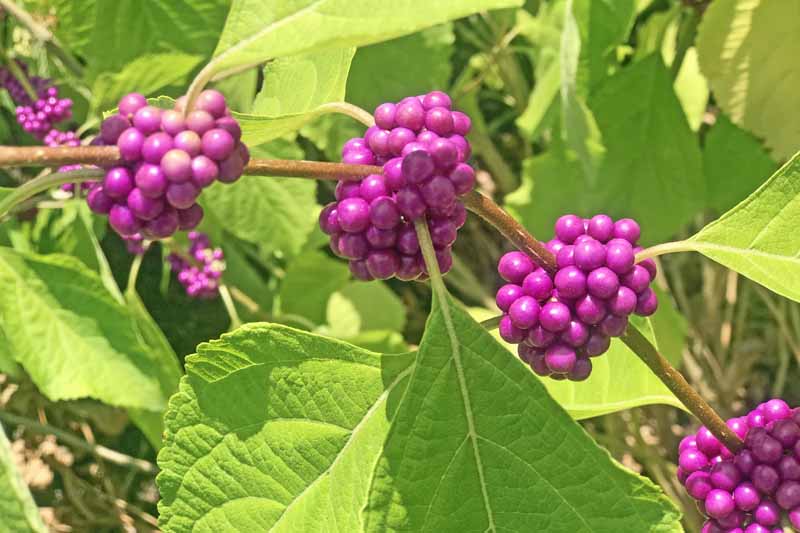
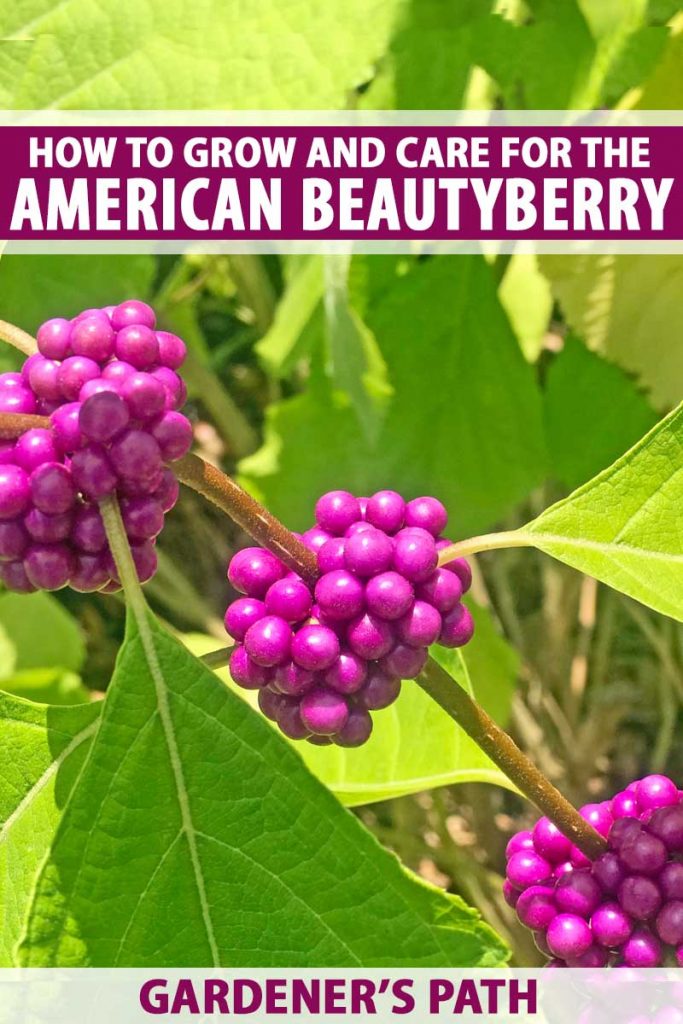
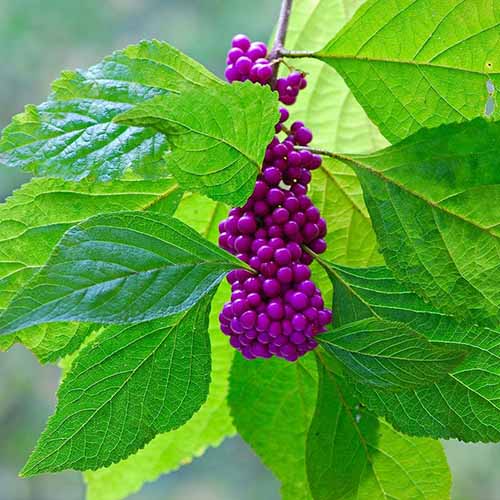
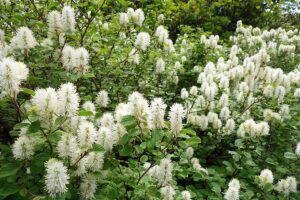
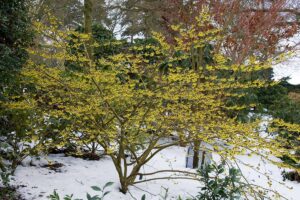
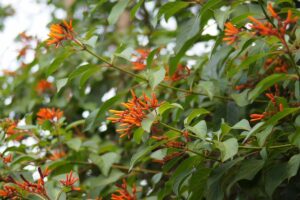
I have this is a very sunny spot in my garden in San Antonio and had to water it twice a day this summer to keep it alive. I think I’ll probably move it to a shadier spot in the next month or so. Thanks for this article…very helpful!
Hi Christine! I’m not too surprised. In our neck of the woods, these plants do better with some shade. And even in the shade, you’ll need to provide some supplemental water while the plant is young.
The 1st photo below “Where to buy”, is not of an American beautyberry, but of an exotic Callicarpa and/or exotic cultivar.
Thank you, Claude! We’ll check into this.
Thanks for letting us know, Claude! We’ve updated this article.
So, I planted about 25 seedlings that I purchased from my state environmental group. Only have sprouted the first year. Then about 30% are starting to come out this year. Plus, they seem to start new from the ground every year. In fact, only 3 are producing leaves from last year’s growth. The other 4 or 5 have new sprouts. During the first year, all of the ones that lived from the initial planting were fresh sprouts. I have other plants nearby that I purchased from the same agency. Other than watering them, it sounded like there was little to… Read more »
Hi Dan, I’m not sure if your plants are in or outdoors, but here’s a few general tips to help you. Seeds should be soaked for 24 hours prior to planting. Germinate seeds in fall to plant out in spring, and early summer for planting out in fall. Plant shallowly in pots or trays, just barely covering the seeds with sterile potting mix. Firm the soil lightly and water gently. Place in a cool, bright location (not lower than 45 degrees F) and transplant out when well established, in about 3 months time. These shrubs don’t usually require fertilizer, but… Read more »
In NJ, I have four beautyberry shrubs in west-facing planting beds, and while the deer browse them, they do not destroy them. The berries produce so many volunteers that they have become a nuisance. I have transplanted a couple of the volunteers, and they are turning into sturdy, happy shrubs in various locations and soil conditions. I came to this site looking for transplant and growing advice, because I want to transplant my originals to areas where the volunteers won’t be such a nuisance.
What is the best way to collect beauty berry seeds? I have a lot growing on my property in SE Texas but the berries disappear quickly thanks to birds and deer. Do I need to let the berries ripen completely on the plants?
Hi Janet,
The seeds DO need to ripen completely before harvesting to be viable. To collect them, remove the seed from the fruit and either dry them for sowing later, or plant them right away.
Hmm, as far as the birds go – how about putting paper bags over a couple of branches with berry clusters to protect them from the birds long enough to ripen?
This may work for the deer, too – I’m not sure how persistent yours are. Otherwise we have a couple of articles about deer-proofing that might help.
https://gardenerspath.com/how-to/animals-and-wildlife/deer-proofing-garden/
https://gardenerspath.com/how-to/animals-and-wildlife/deer-fence-diy/
I have hundreds on my property just east of San Antonio and have yet to have mosquitoes on my property.
Have never heard of them keeping mosquitoes away. We have quite a few of these in our nursery, and come to think of it, I don’t remember seeing any mosquitoes in the area under the tree line. This is good to know.
I have two calicarpa, had plenty of flowers but not one berry has appeared. Can you advise me please?
Do the leaves look healthy, Tony? Did you spray your plants with any types of chemicals? Changes in the weather (periods of drought, for example) can cause plants to fail to set fruit, as can inadequate fertilization if the flowers are not visited by pollinators. Chemical pesticides can also kill off beneficial insects. Since you already have two plants, that should be enough for cross-pollination if pollinating insects are present, but you might try planting other flowering plants that attract pollinators in the vicinity to boost your chances of berry production next year.
I have this beauty in part sun/shade area and it had bee doing great until about a few days ago. I forgot to water a couple of days and drenched it later but for some reason it hasn’t recovered. The leaves have wilted and yellowed/light green. I fertilized it, but still looks the same. I have kept the ground moist. I thought about digging out of the ground and put it in a pot with potting soil. Please give your opinion if that is a good idea or not. Thank you!
I’m going to make some suggestions that will help you keep all your bases covered with this beautyberry. You can indeed try growing it in a pot, but I would recommend taking several softwood stem cuttings about five inches long and rooting them to grow in a pot (see more extensive instructions in the article above, and in our piece on propagation). This time next year, they should be ready to plant out. As for the bush itself, it’s probably suffering from water deprivation. The fertilizer doesn’t help with that, because beautyberries don’t really need it. It could be a… Read more »
I have many American Beautyberry plants growing wild on my land in South Georgia USA. They only grow well under other trees. When camping I take 4 leaves and tear one up and put on each corner of the camp and have no issues with mosquitoes.
Should Beautyberry be trained on a trellis?
Hello Vicki! Beautyberry is a shrub, not the type to be trellised. If you want it to both look tidy and produce the most berries possible, it’s a good idea to keep it pruned. The best time is late winter. You can cut about a fourth of the height off the top to shape it, or cut the whole thing down to just a foot above the ground and let it regrow in the spring. Don’t fret that you’ll be cutting off the beautiful berries. These woody shrubs only flower and produce berries on new wood that grows in the… Read more »
Hello Vicki. Rather than a trellis, you can contain the sprawl with these shrubs by pruning them in later winter. You can take off the top quarter of the height or cut the entire bush to a foot above the ground.
In the spring, it will take off, just like last year. But the shape will be more appealing than it would if you just let it keep growing year to year without pruning.
I just purchased my beautyberry shrub a few weeks ago. It is loaded with new green berries and some more mature ones. The leaves seem to be wilting. They appear very thin and dry. Is this normal? We have tried to keep it watered, but are afraid we might be over-watering. How do we know if we are over-watering?
I cut mine back because it was getting out of control. Now the berries are deep purple. Did I damage the bush? Will it die?
Hello Cindy! I feel like your beautyberry might not be super happy, but it will probably be okay! Ideally, the best time to prune or shape one of these is in late winter. At that time, you can either cut it all off to one foot above the ground, or shape and trim just about the top quarter of the shrub. Either approach will help the shrub form more of those beautiful berries without looking so rangy, and if you prune almost the whole thing, it will be shorter next year. Come spring, it will grow back. To be on… Read more »